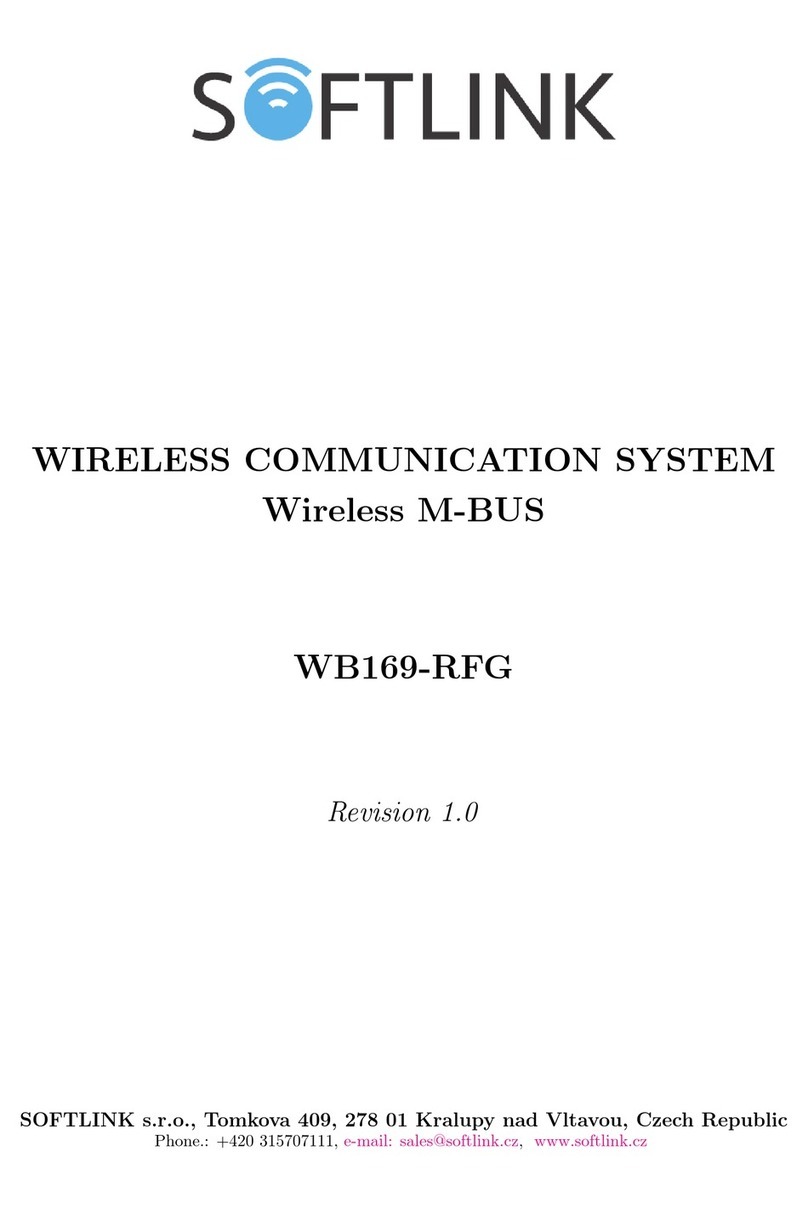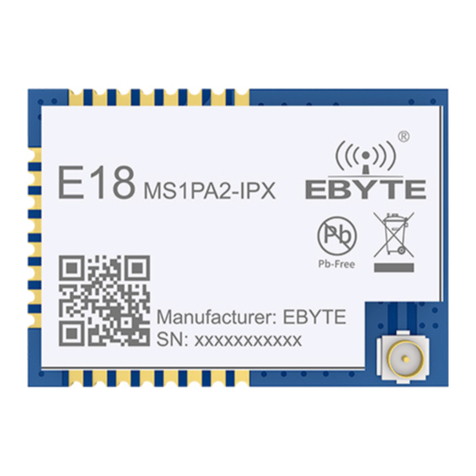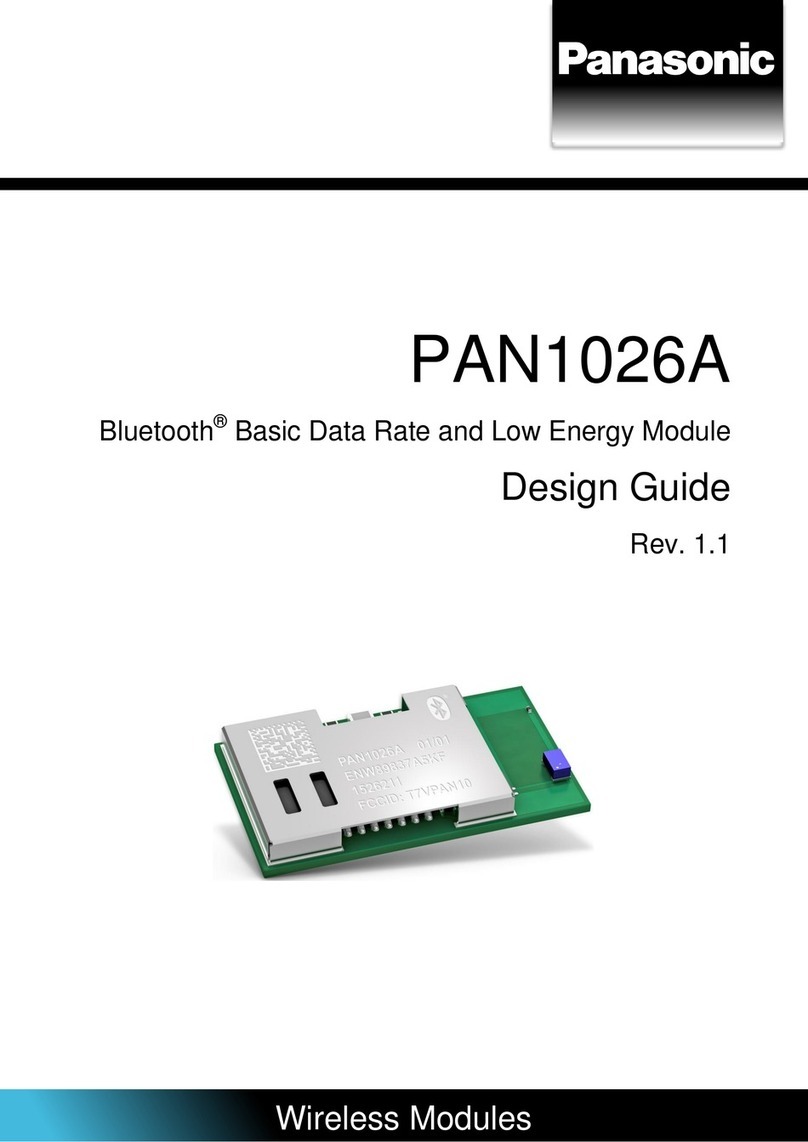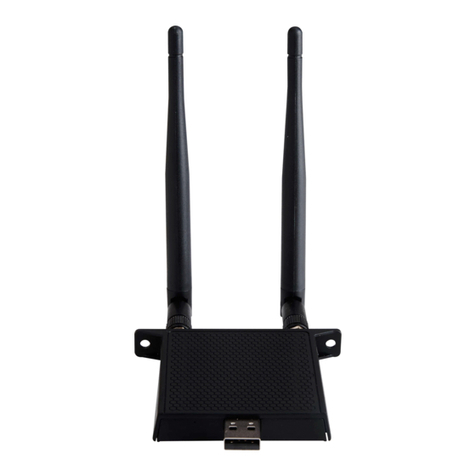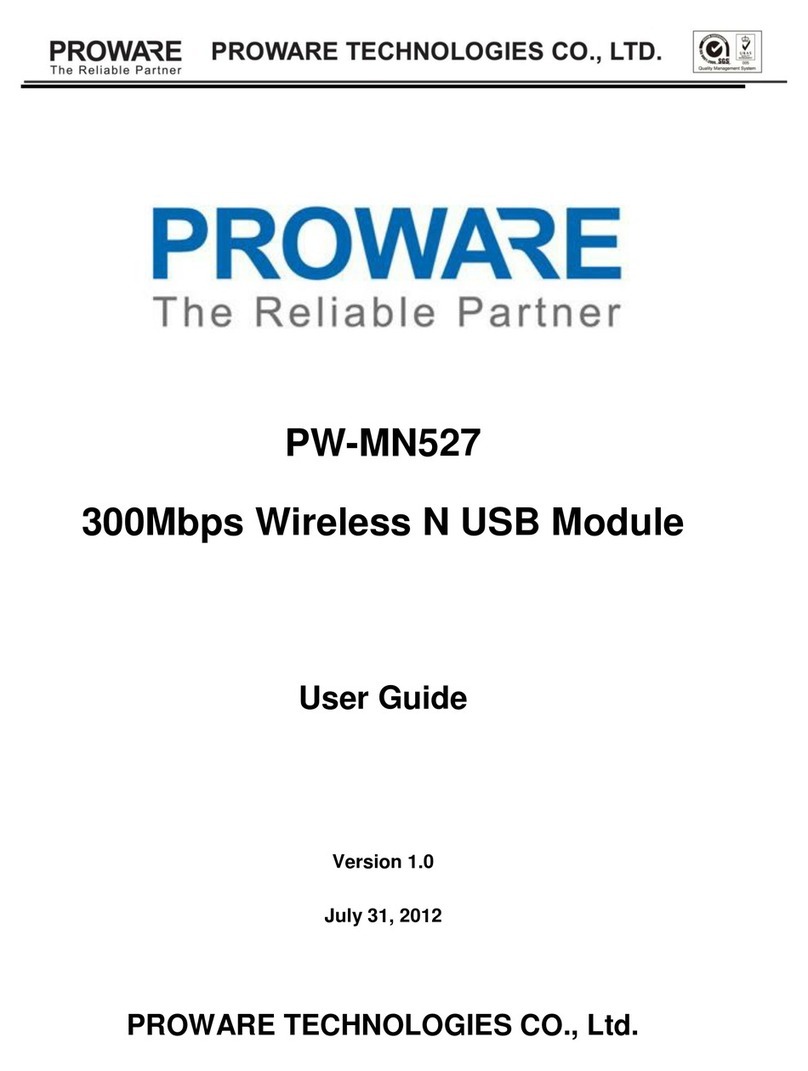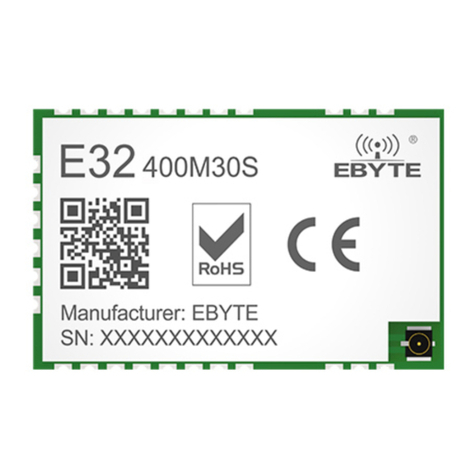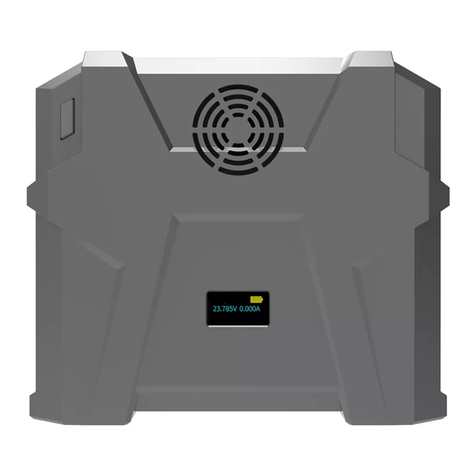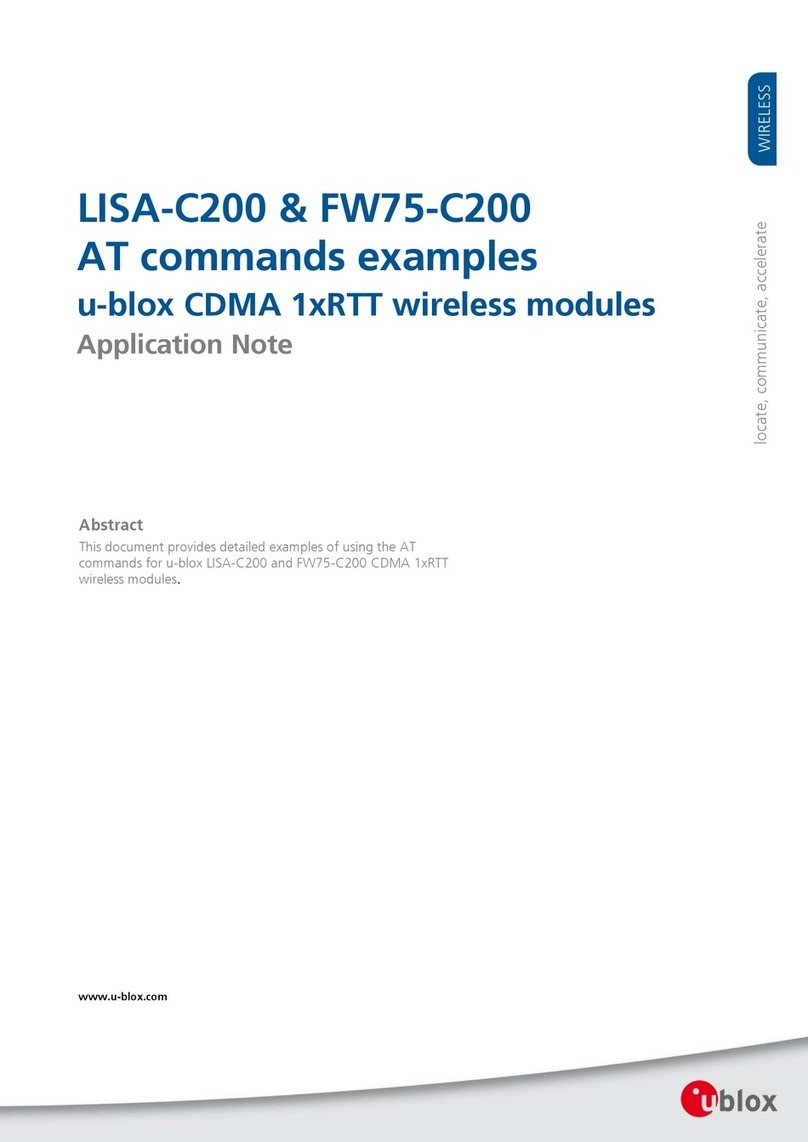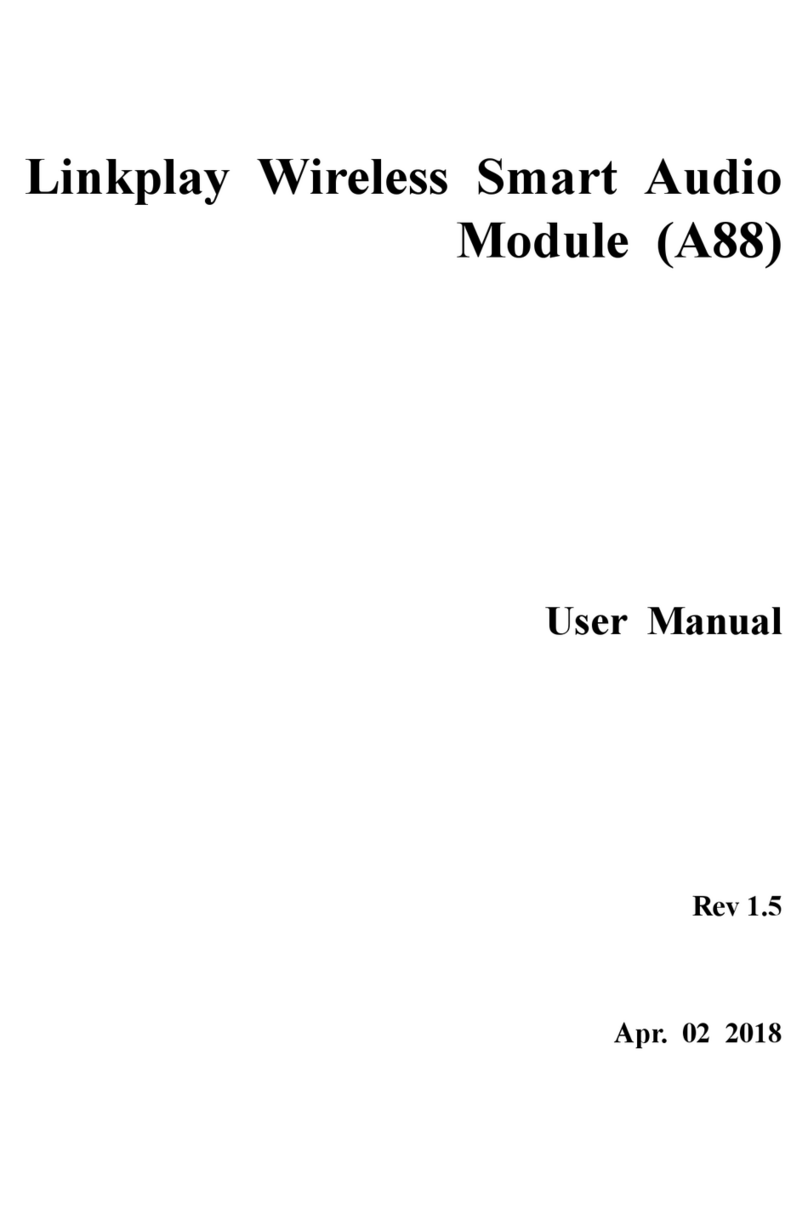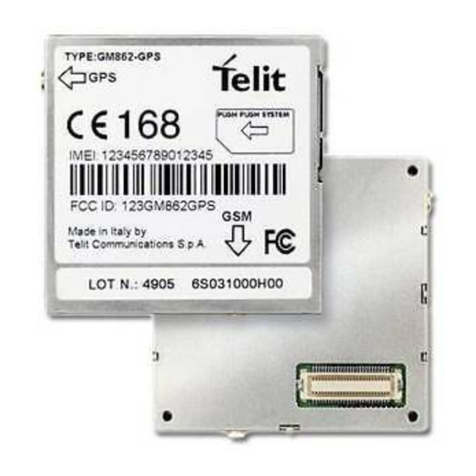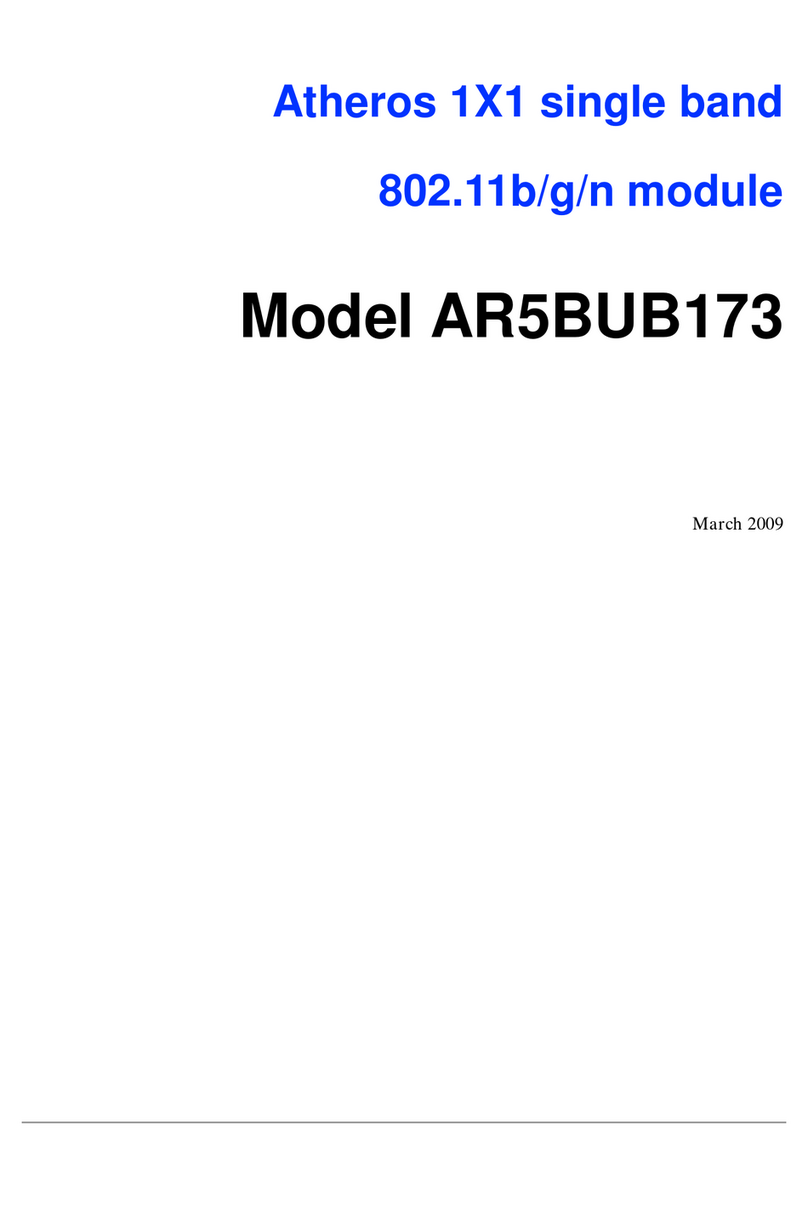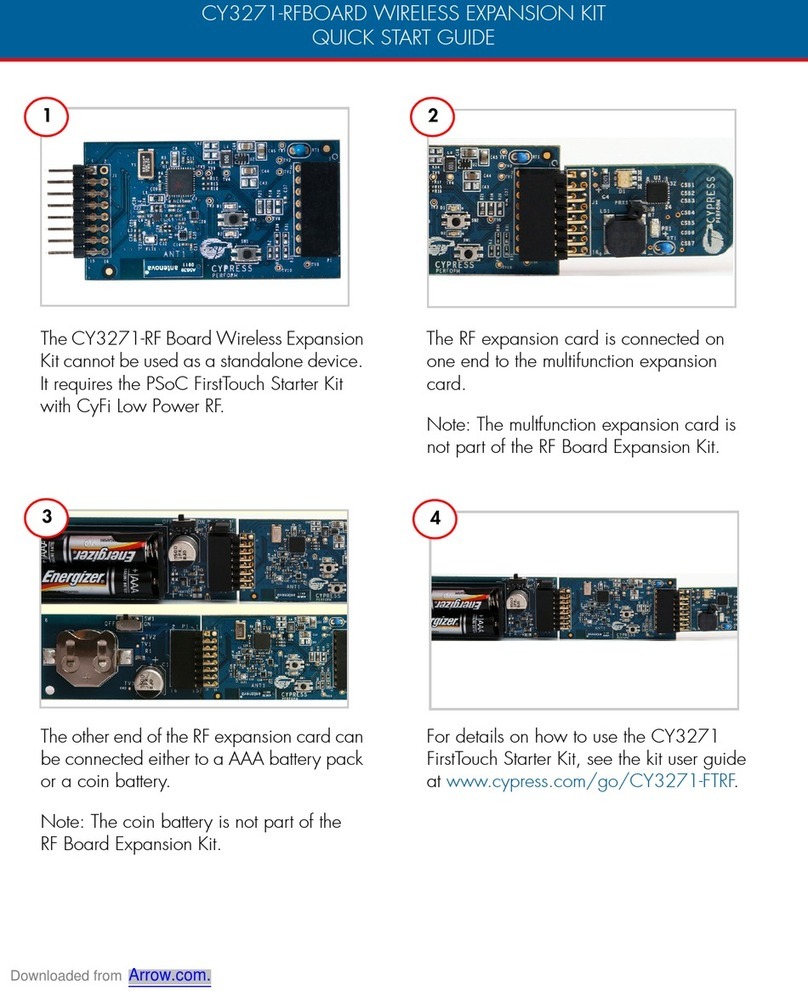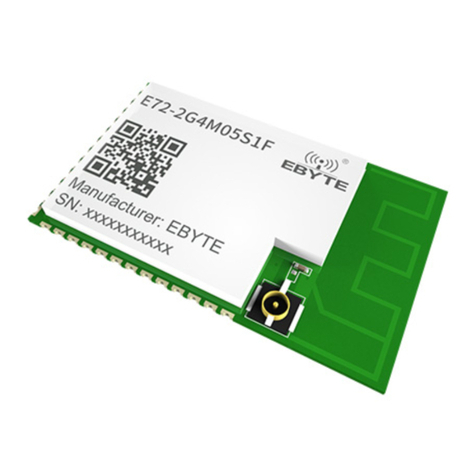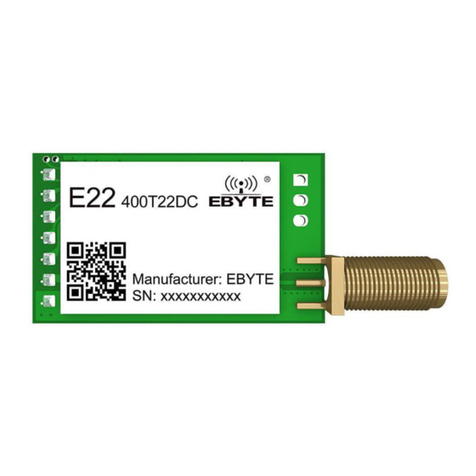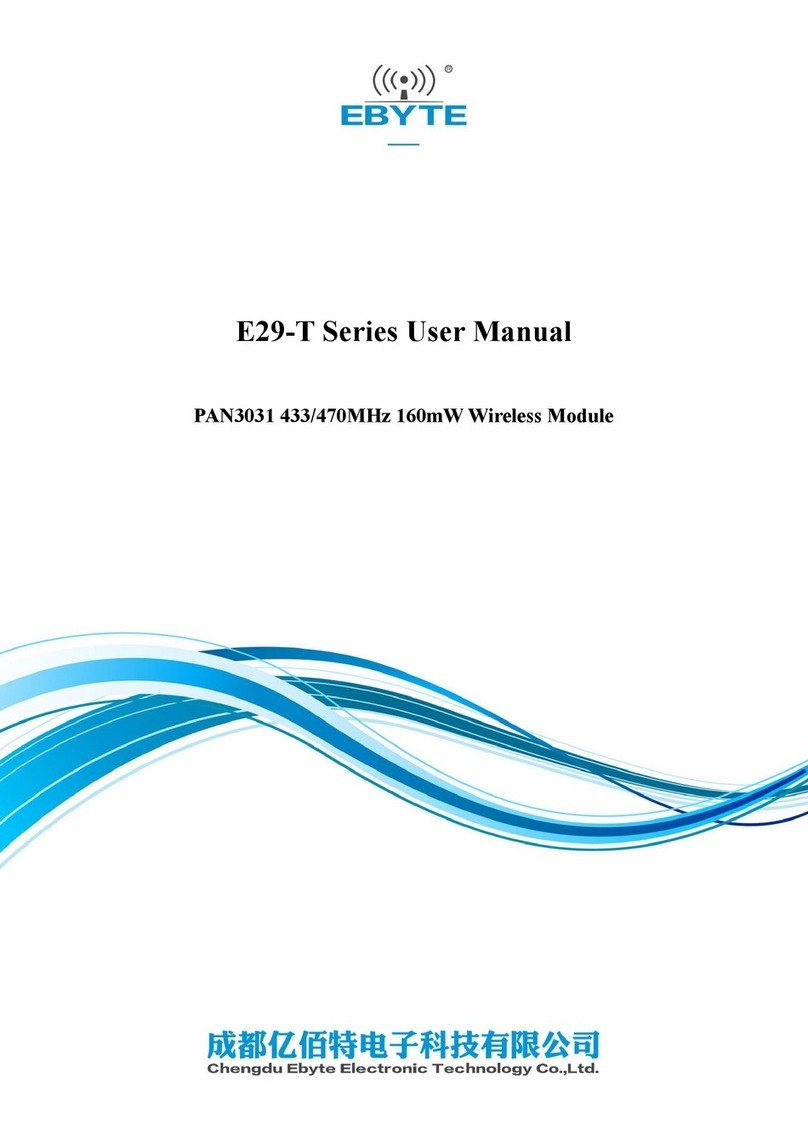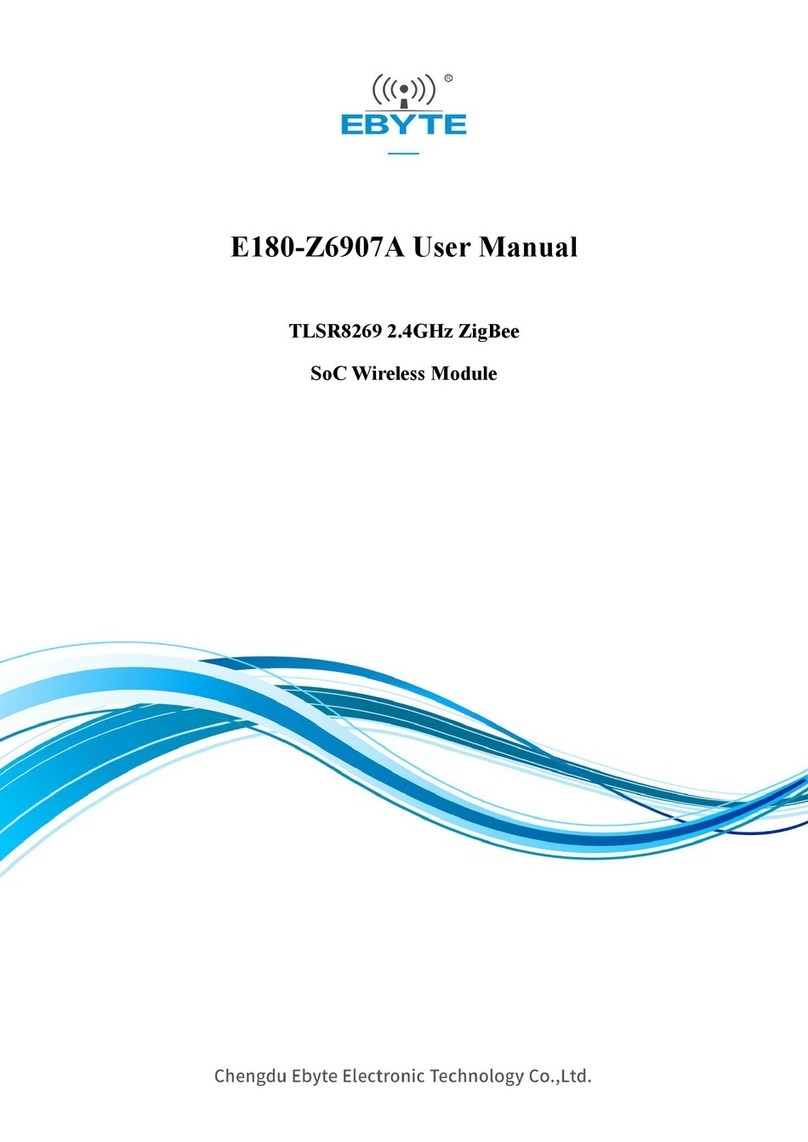SOFTLINK WB169-430 User manual

Contents
1 Introduction 1
1.1 Wireless M-BUS Communication Protocol ................................ 1
1.2 Module usage ................................................. 1
1.3 Hardware features and power supplying .................................. 2
2 Technical parameters overview 3
3 Configuration of the WB169-430 module 4
3.1 Setting of WB169-430 module parameters by configuration cable .................... 4
3.1.1 List of WB169-430 module configuration parameters and commands .............. 4
3.1.2 ”System commands” group for general diagnostics ........................ 6
3.1.3 Commands for writing of configuration and reset ......................... 6
3.1.4 ”WMBUS” group commands for setting of messages ....................... 7
3.1.5 ”Modem commands” group for RF-subsystem diagnostics .................... 10
3.1.6 Commands for setting of watermeter reading ........................... 10
3.1.7 Commands of ”Utils” group for setting of module common functions .............. 11
3.1.8 Displaying of other operational entries in the list of parameters ................. 13
3.2 Setting of parameters by using of optical converter ............................ 13
3.2.1 Overview of module configuration parameters ........................... 17
3.3 Structure of module data messages ..................................... 18
3.3.1 Iinformation message ......................................... 18
3.3.2 Alarm message ............................................ 20
4 Operational conditions 21
4.1 General Operation Risks ........................................... 21
4.1.1 Risk of mechanical and/or electric damage ............................. 21
4.1.2 Risk of premature battery discharge ................................ 21
4.1.3 Risk of damage by excessive humidity ............................... 21
4.2 The condition of modules on delivery .................................... 22
4.3 Modules storage ............................................... 22
4.4 Safety precautions .............................................. 22
4.5 Environmental protection and recycling .................................. 22
4.6 WB169-430 module installation ....................................... 22
4.7 Module and meter replacement ....................................... 24
4.8 Module dismantling ............................................. 25
4.9 Functional check of the module ....................................... 25
4.10 Operation of the WB169-430 module .................................... 25
5 Troubleshooting 26
5.1 Possible causes of module failures ...................................... 26
5.1.1 Power supplying failures ....................................... 26
5.1.2 System failures ............................................ 27
5.1.3 Transmitter and receiver failures .................................. 27
5.1.4 Failures of communication with watermeters ........................... 28
5.2 Troubleshooting procedure .......................................... 28
6 Additional information 29
List of Tables
1 Overview of WB169-430 module technical parameters .......................... 3
2 Overview of WB169-430 module configuration parameters ........................ 17
3 Structure of Wireless M-BUS message header of the WB169-430 module ................ 18
4 Description of variables of WB169-430 module info-message data block ................. 18
WB169-430 i

List of Figures
1 View of the WB169-430 module ....................................... 2
2 WB169-430 module configuration table ................................... 14
3 Configuration forms of WB169-430 module in ”SOFTLINK Configurator” application ........ 16
4 Form for setting of basic parameters and list of watermeters in reach acquired by RADAR function . 16
5 View of WB169-430 module information message received by WMBUSAN4 analyzer ......... 19
6 Encrypted and decrypted message of the WB169-430 module ...................... 19
7 Structure of alarm message about the reset of WB169-430 module ................... 20
8 Set of WB169-430 module components with rod antenna ......................... 23
9 Detail of WB169-430 module PCB ..................................... 23
10 Example of ”Radar” application table ................................... 26
WB169-430 ii

1 Introduction
This document describes features, parameters and setting possibilities of the WB169-430 module, which is used for
remote reading of iPERL series watermeters by Sensus, that are equipped with 430 MHz data transmitter, and
for resending of read data to the superior remote reading system in form of 169 MHz Wireless M-BUS standard
messages.
1.1 Wireless M-BUS Communication Protocol
Wireless M-BUS is the communications protocol described by international standards EN 13757-4 (physical and
link layer) and EN 13757-3 (application layer), which is intended primarily for radio transmission of remote reading
values from consumption meters and sensors. Protocol Wireless M-BUS (hereinafter ”WMBUS”) is based on a
standard M-BUS definition (uses the same application layer as M-BUS standard), but is adapted for data transfer
via radio signals.
Communications via WMBUS protocol works in Master-Slave mode, where ”Master” is a collecting data device,
”Slave“ is a providing data device. Slave device could be integrated or external radio module transmitting data
from the meter/sensor. The communications protocol WMBUS defines several communication modes (simplex or
duplex). If working in simplex mode a ”Slave” device only transmits messages to ”Master” that these messages
receives. If working in ”bidirectional” mode, it is possible to use a back channel from ”Master” device to ”Slave”
device for ”Request” type of messages, that can contain e.g. request for the change of slave’s configuration.
Wireless M-BUS communications protocol partially supports repeating of the messages. If receiving from some
”Slave” device is not possible because of the low level of radio signal, the messages can be re-transmitted (repeated)
by appointed element of the radio network (repeater or slave with such functionality). Each repeated message is
marked as ”repeated message” so as not to be repeated again.
As the receiver of the WB169-430 module is used for receiving of watermeter messages, back channel features cannot
be used for this type of device.
1.2 Module usage
The WB169-430 module can be used as a local communication gateway for remote reading of Sensus iPERL-series
watermeters. The module receives regular radio messages with readings (”Bubble Up” messages) from watermeters
in its radio-reach and stores the readings to its memory. In pre-defined intervals the module broadcasts aggregate
of received data to the superior remote reading system (AMR) in form of Wireless M-Bus radio-messages in 169
MHz frequency band (”INFO” messages).
The WB169-430 module can by used for remote reading up to 5 iPERL watermeters placed in its radio-reach
(that is up to hundreds meters). Each watermeter transmits BUP messages with fixed period of 15 seconds. The
module receives data from watermeters in regular ”receiving windows”, that are opened with preset broadcasting
period (e.g. every 120 minutes). Immediately after closing of the receiving window the module broadcasts received
data from all watermeters to the superior system in one Wireless M-Bus message.
Each module has its table of read watermeters, where there are IDs (serial numbers) of up to five meters that should
be read by the module. If there are other watermeters in the reach, their BUP messages are ignored. The module
can re-send original watermeter alarms (Sensus alarm flags) as well as its own alarm messages.
Each INFO-message contains following data for each read watermeter:
- watermeter ID (serial number)
- watermeter counter value (reading)
- watermeter original alarm flag
- watermeter RF signal strength value (RSSI)
More detailed information about the message content and structure can be found in the paragraph i 3.3.
Besides the watermeter data each message contains identification of the module itself and current statuses of its
parameters (uptime, battery voltage, processor temperature and transmitting power). The messages are broadcasted
either in open mode (without encryption), or encrypted by AES-128 encryption key. The messages are transmitted
on the 169.4 MHz frequency with data rate from 2.4 kbps to 19.2 kbps (according to used frequency channel).
Messages can be received either by WB169-RFE communication gateway (WMBUS Ethernet GateWay produced
by SOFTLINK), or any other ”Master” device that complies with the Wireless M-BUS EN 13757-3 / EN 13757-4
standard for 169 MHz frequency band.
WB169-430 1

1.3 Hardware features and power supplying
The module is enclosed in humidity-proof plastic casing with IP65 degree of protection and can be used in interiors
as well as in exteriors. The casing is designed for mounting on the wall or other construction element (beam,
pipe...). Module can be treated with an additional sealing by high-adhesion silicon filling, that can ensure proof
against inundation by water (IP68 grade). If this treatment is required from the manufacturer, it must be ordered
separately.
The module is power supplied by internal battery with up to 8 years lifetime for frequency of 6 broadcastings per
day. Battery lifetime can be negatively influenced by shorter broadcasting period, or by storing and operation in
sites with the temperatures exceeding the recommended range.
The module can be controlled and configured either by configuration cable, or wirelessly, by infra-red optical
converter. The module is equipped with the special circular aperture (”peephole”) for magnetic fixing of the optical
converter.
External appearance of the WB169-430 module is shown in the figure 1.
Figure 1: View of the WB169-430 module
WB169-430 2

2 Technical parameters overview
Overview of WB169-430 module technical parameters is shown in the Table1below.
Table 1: Overview of WB169-430 module technical parameters
RF subsystem parameters
Frequency band * 169.40625 to 169.46875 MHz
Modulation * 2-GFSK, 4-GFSK
Bandwidth * 12.5 or 50 kHz
Transmitting power 500 mW
Communication protocol Wireless M-BUS
Communication mode (by EN 13757-4) N1, N2
Transmission speed * 2400, 4800, or 19200 Baud
Antenna connector SMA female
Antenna characteristic impedance 50 Ω
iPERL receiver parameters
Carrier frequency 433,7429 MHz
Modulation 2GFSK
Receiver sensitivity 110 dBm
Antenna integrated
Max. number of read watermeters 5
Configuration interface RS232
Transmission speed 9600 Baud
Operation mode asynchronous
Transmission parameters 8 data bits, 1 stop bit, none parity
Signal level TTL/CMOS
Optical configuration interface
Transmission speed 115 200 Baud
Optical wavelength 870 nm
Optical interface specification IrPHY 1.4 standard
Power supplying
Lithium battery voltage 3,6 V
Lithium battery capacity 13 Ah
Weight and dimensions
Length 145 mm
Width 45 mm
Height 105 mm
Weight cca 300 g
Storage and installation conditions
Installation environment (by ˇ
CSN 33 2000-3) normal AA6, AB4, A4
Operation temperature range (-20 ÷40) ◦C
Storage temperature range (0 ÷40) ◦C
Relative humidity ** 95 % (w/o condensation)
Degree of protection ** IP65 or IP68
* in reliance on selected frequency channel - see EN 13757-4, Mode N, Physical link parameters (Table 18
** modules treated by additional silicon filling are waterproof with IP68 degree of protection.
WB169-430 3

3 Configuration of the WB169-430 module
Configuration parameters of the WB169-430 module can be displayed and changed from the common computer
(PC) by one of these methods:
- with using of ”USB-CMOS” converter and configuration cable connected to the module;
- wirelessly, with using of ”USB-IRDA” or ”BT-IRDA” converter;
Technique of interconnection of the module with configuration computer and general rules of configuration are
described in detail in the chapter 2 of ”Configuration of wacoSystem product family devices”, that can be
downloaded from the producer website:
www.wacosystem.com/support/
www.softlink.cz/en/documents/
The description and meaning of all configuration parameters that can be checked and changed by cable can be
found in the section 3.1 ”Setting of WB169-430 parameters via configuration cable”.
Description of interconnection of the converter with PC (”USB-IRDA”) or smartphone (”BT-IRDA”) and gen-
eral rules of configuration with using of optical converters are described in the chapter 3 of above mentioned
manual ”Configuration of wacoSystem product family devices”. The description and meaning of the parameters
that can be changed by optical converter can be found in the section 3.2 ”Setting of parameters by using of optical
”IRDA” converter”.
3.1 Setting of WB169-430 module parameters by configuration cable
In following part of the document there is a description of these parameters of the WB169-430 module, that can be
displayed and examined from PC connected to the module by configuration cable. Some of the parameters can be
changed by configuration commands entered ”from the console”.
3.1.1 List of WB169-430 module configuration parameters and commands
List of all configuration parameters of the module can be displayed by entering of ”show” command and pressing
of ”ENTER” key. The following list of parameters will display in the terminal window:
mon#show
----- Configation -----
Timezone : 1
MBUS ID : 00900011
MBUS version : 6
MBUS manufacturer : SFT
MBUS medium : 7
MBUS power : 3 (20 dbm)
MBUS mode : N1
WMBUS channel : 3 - 169,43125 Mhz
Send periode : 30
Sensus meters :
ID[0] : 130551476
ID[1] : 130551474
ID[2] : 130551477
ID[3] : 130551475
ID[4] : 130551473
Data will be encrypted by AES
Next send : 29 min.
No. sent : 1 msg(s)
No. recv : 0 msg(s)
Conf. version : 7
SW version 1.02, date Jul 31 2020
mon#
WB169-430 4

List of all configuration commands (”HELP”) can be displayed by entering of ”?” command into the command
line and pressing of ”ENTER” key. The following list of commands will display in the terminal window:
mon#?
Help :
--- System commands ---
deb : Show or set debug level
ta : Show tasks
mb : Show mail boxes
du addr : Dump memory
rb addr : Read byte from addr
rw addr : Read word from addr
rd addr : Read dword from addr
sb addr val : Set byte on addr
sw addr val : Set word on addr
sd addr val : Set dword on addr
port : Show port [a,b,..]
show : Show info
write : Write configuration to flash
cread : Read configuration from flash
clear : Clear configation and load defaults
--- WMBUS commands --- ---
mid : Show or set MBUS ID (0 - 99999999)
power : Show or set MBUS power (1 - 5)
manuf : Show or set MBUS manufacturer code (AAA)
info : Show or set MBUS info string (0-30 chars)
vers : Show or set MBUS version (0 - 255)
medium : Show or set MBUS medium (0 - 255)
periode : Change periode of send 0 - disable, >0 period in minutes
mode : Set WMBUS mode 1 - N1, 2 - N2
chan : Set WMBUS channel, type ? for help
ekey : Set encrypt key W-MBUS, point ’.’ no encrypt
skey : Set encrypt key Sensus
sid [index] [value] : Set Sensus meter ID
--- Modem commands ---
mr : Modem receive mode 0 - off, 1 - on 169MHz, 2 - on 433MHz
mt test time : Set test on modem, 1 - TX carrier, 2 - TX sync, time is in second, default 10
ms : Get modem state
mi : Get modem info
recvwin : Set receive window in sec.
radar : show radar table
--- Utils ---
tz : Time offset in hours
ppm : Set RTC ppm
time : Show or set rtc time, set as BCD : 0x102033 is 10:20:33
date : Show or set rtc date, set as BCD : 0x171231 is 2017-12-31
uptime : Show uptime
sens : Show sensors
mfreq : Set or get xtal frequency correction
sfreq : Set frequency correction from analyzer in Hz, example : 196431200
cfreq : Set +- frequency correction, 1 = 1Hz
sendp : Send nx WMBUS messages
send : Send WMBUS message
reset : Reset device
? : Show this help
mon#
Overview of configuration parameters with short description of their meaning can be also found in table 2on the
page 17. The meaning of individual parameters and detailed description of their usage can be found below.
WB169-430 5

3.1.2 ”System commands” group for general diagnostics
Commands ””deb”, ”ta”, ”mb”, ”du addr”, ”rw addr”, ”rb addr”, ”rd addr”, ”sw addr”, ”sb addr”,
”sd addr” and ”uptime” are used for troubleshooting and repair of the device in a factory. Manufacturer
strongly recommends not to use these commands during common operation.
Other system commands ”show” (configuration statement) and ”?’ (”Help”) are described in previous part of
section3.1.
By using of ”port” command an actual setting of module ports can be displayed. This command is intended only
for module diagnostics.
3.1.3 Commands for writing of configuration and reset
The module contains two sets of configuration: operating configuration and saved configuration. At the start of the
system the module copies saved configuration to operating configuration, with which continues to work. If the user
changes configuration parameters, it does so only in operating configuration.
If the current operating configuration was not stored to FLASH memory, the module returns to the saved configura-
tion after reset. If the parameter should be changed only temporarily (for example shorten of the broadcasting period
during installation), it is not necessary to save operating configuration in FLASH memory (after the work finishing
module can be returned to normal configuration by its reset). If the parameter should be changed permanently,
there is necessary to save configuration to FLASH memory.
If operating configuration corresponds to the saved set (ie. there are no differences between commands in FLASH
and in the operating set), the module will ”report“ prompt in the format ”mon#”. If operating configuration was
changed so that it no longer matches to the saved set, the module will report prompt in the format ”cfg#”.
Every time the current configuration is saved into FLASH memory the value of the ”Configuration version” param-
eter increases by one and the prompt changes to ”mon#”. The parameter resets to zero by erasing of the FLASH
memory.
Current operating configuration can be displayed by using of ”show” command (see paragraph 3.1.1):
cfg#show
Current operating configuration can be rewrite the to FLASH memory by using of ”write” command:
cfg#write
Writing config ... OK, version 3
Reading of the configuration from FLASH memory can be done by by using of ”cread” command (for older some
modifications the command is ”read”):
cfg#cread
Reading config ... OK, version 3
The configuration can be erased in Flash memory by using of ”clear” command:
cfg#clear
Clearing configuration ... OK, version
This command deletes all configuration parameters from the FLASH memory, so it is necessary to set them again.
If after erasing all parameters in FLASH memory the module goes to reset, default set of parameters (configured
in the program of the device) is duplicated to FLASH memory. There is only one exception - frequency constant
keeps the actual value also after cleaning of FLASH memory by ”clean” command.
This command is recommended to use only by users with good knowledge of the system or after
consultaion with the manufacturer.
The module reset can be performed by using of ”reset” command.
WB169-430 6

3.1.4 ”WMBUS” group commands for setting of messages
This group of commands serves for setting of Wireless M-BUS addressing of the WB169-430 module and for setting
of broadcasting parameters. There are following command:
mid setting of device fabrication number (”M-BUS ID” – range 0 to 99999999)
manuf setting of manufacturer code (”Manufacturer” - supplement of M-BUS address)
vers setting of ”addressing version” (”Version” - supplement of M-BUS address)
medium setting of media code (”Medium” - supplement of M-BUS address)
info setting device name
periode setting of regular messages broadcasting period
power setting of transmitting power (mW)
mode setting of communication mode (1 - N1 mode, 2 - N2 mode)
chan setting of frequency channel (choice from 7 options)
ekey setting of encryption key (”.” - encryption disabled)
Variable ”M-BUS ID” is a serial number of the device in M-Bus standard identification system. The address is
”read only” type for the WB169-430 module and cannot be changed. Assigned serial number of the module can be
displayed by”mid” command (without parameter):
cfg#mid
MBUS ID : 00112233
cfg#
Variable ”Manufacturer” is an international code of device producer according to the M-Bus standard. The code
is ”read only” type for the WB169-430 module, its value is ”SFT” (Softlink) and it cannot be changed. Assigned
manufacturer code can be displayed by”manuf” command (without parameter):
cfg#manuf
MBUS manufacturer : SFT
cfg#
Variable ”Version” is number of addressing version according to the M-Bus standard (each type and modification
of the device could have its own line of serial numbers). The code is ”read only” type for the WB169-430 module
and cannot be changed. Assigned version number can be displayed by ”vers” command (without parameter):
cfg#vers
MBUS version : 101
cfg#
Variable ”Medium” is an international code of measured medium (water, energy, physical quantity..) according
to the M-Bus standard. The variable is editable and it is factory preset to 07 (”Water”). Current setting of the
medium value can be displayed by ”medium” command (without parameter). Medium parameter can be changed
by entering of required code of medium according to M-Bus standard (range: 0 to 255).
Example of medium code setting to ”02” value (electricity):
cfg#medium
MBUS medium : 7
cfg#medium2
MBUS medium changed from 7 to 2
cfg#
Note: The full identification of the device in M-Bus standard systems is done by combination of four ID components:
”M-BUS ID”, ”Manufacturer”, ”Version” and ”Medium”. This combination must be unambiguous that means
there cannot exist two M-Bus devices worldwide, that have the same combination of all these parameters. If fixed
configuration of the address components used, producer of the device is responsible for unique setting of ”read
only” address components for each device. If M-Bus address components are configurable, operator of the M-Bus
system can use serial number of connected meter in combining with its type, subtype and manufacturer. Using of
”independent” addressing line is possible only in that case, if the operator of the system owns its M-Bus manufacturer
code and can assure that the identification of all operated devices under his code will be unique
WB169-430 7

”Info” command can be used for setting of device name that is a part of each broadcasted message (see para-
graph 3.3). The parameter is preset from the factory to ”none (no entry)” value. By using of ”info” command
(without parameter) an actual value of the name can be displayed. The device name can be set by entering of any
string of characters after ”info” command.
Example of displaying, setting and follow-up checking of the device name:
cfg#info
MBUS manuf info : ’ABC’
cfg#info XYZ
Change MBUS manuf info from : ’ABC’ to : ’XYZ’
cfg#info
MBUS manuf info : ’XYZ’
cfg#
Maximum length of the string is 29 characters. The only basic set of characters can be used (without diacritics).
It is not recommended to change this parameter.
”Periode” command serves for setting of broadcasting period of regular info messages. The value of the parameter
is factory preset to 60 minutes. Current value can be checked by ”periode” command (without parameter).
Broadcasting period can be changed by entering of required number of minutes after ”periode” command.
Example of displaying, setting and follow-up checking of broadcasting period:
cfg#periode
Periode is 60 min.
cfg#periode 30
Periode changed from 60 to 30 min.
cfg#periode
Periode is 30 min.
cfg#
Group of ”power” (transmitting power), ”chan” (frequency channel), ”mode” (communication mode) and
”ekey” (encryption key) commands is intended for setting of module RF-subsystem parameters.
The command ”Power” is used for adjusting of the module broadcasting power. Factory setting is 100 mW
(average power). Actual value of the power can be displayed by using of the ”power” command without parameter.
Transmitting power can be set-up by entering of the number of power level. There are five levels available:
- value ”1” for transmitting power 14 dBm (25 mW)
- value ”2” for transmitting power 17 dBm (50 mW)
- value ”3” for transmitting power 20 dBm (100 mW)
- value ”4” for transmitting power 24 dBm (250 mW)
- value ”5” for transmitting power 27 dBm (500 mW)
An example of checking, setting and re-checking of transmitting power:
cfg#power
MBUS power : 3 (20 dBm)
cfg#power 5
MBUS power changed from 3 to 5 (27 dbm)
cfg#power
MBUS power : 5 (27 dBm)
cfg#
The command ”Communication mode” is used for selecting of the module’s communication mode. Factory
setting is N1 (unidirectional), actual setting can be checked by using of ”mode“ command without parameter.
Change of mode can be done by entering of desired option as a parameter of the command. Communication modes
are defined by the Wireless M-BUS standard, accurate choice of relevant communication modes of the module is
stated in the line ”mode” of ”Help” summary (see the paragraph 3.1).
An example of checking, setting and re-checking of communication mode:
WB169-430 8

cfg#mode
Mode N1
cfg#mode 2
CC1120 state 0x0f, marcstate 65, fifo tx 0, rx 0
Mode changed from 1 to 2
cfg#mode
Mode N2
cfg#
The command ”Frequency channel” is used for selecting of the module’s radio frequency channel. Frequency
channels for the particular frequency bands are defined by the Wireless M-BUS standard. Actual setting can be
checked by using of ”chan“ command without parameter. Change of channel can be done by entering of desired
option as a parameter of the command.
An example of checking, setting, saving and re-checking of frequency channel:
cfg#chan
Help :
1 - chan 1a (169.40625 Mhz), 4.8 kbps
2 - chan 1b (169.41875 Mhz), 4.8 kbps
* 3 - chan 2a (169.43125 Mhz), 2.4 kbps
4 - chan 2b (169.44375 Mhz), 2.4 kbps
5 - chan 3a (169.45625 Mhz), 4.8 kbps
6 - chan 3b (169.46875 Mhz), 4.8 kbps
7 - chan 3g (169.43750 Mhz), 19.2 kbps
cfg#chan 1
Channel changed from 3 to 1 : chan 1a (169.40625 Mhz), 4.8 kbps
CC1120 state 0x0f, marcstate 65, fifo tx 0, rx 0
cfg#chan
Help :
* 1 - chan 1a (169.40625 Mhz), 4.8 kbps
2 - chan 1b (169.41875 Mhz), 4.8 kbps
3 - chan 2a (169.43125 Mhz), 2.4 kbps
...
The command ”Encryption key” is used for setting of the encryption key for an encryption of transmitted
messages by using of AES-128 key. The encryption key of 16 bytes length is entered by using of ”ekey“ command,
followed by the string of 16 bytes that can be entered in a decimal or hexadecimal format (see examples).
An example of insertion of the encryption key in hexadecimal format:
cfg#ekey 0x1a 0x2b 0x3c 0x4d 0x5e 0x6f 0xa1 0xb2 0xc3 0xd4 0xe5 0xf6 0x77 0x88 0x99 0xaf
Setting encyption key : 1a 2b 3c 4d 5e 6f a1 b2 c3 d4 e5 f6 77 88 99 af
cfg#
An example of insertion of the encryption key in decimal format:
cfg#ekey42 53 159 188 255 138 241 202 136 21 98 147 235 15 145 136
Setting encyption key : 2a 35 9f bc ff 8a f1 ca 88 15 62 93 eb 0f 91 88
cfg#
If the encryption key is set to the module’s configuration, an information ”Data will be encrypted by AES”
displays in the list of configuration parameters (see chapter 3.1.1)
Encryption can be switched off by setting of ”.” (dot) parameter after the ”ekey“ command:
cfg#ekey.
Encyption disabling
cfg#
In this case an information ”Data will be unencrypted” appears in the list of configuration parameters.
WB169-430 9

3.1.5 ”Modem commands” group for RF-subsystem diagnostics
This group of commands comprises commands for setting of radio-frequency sub-system of the module. These
commands are used primarily for the initial setting of the module in factory. There are following commands:
mr receiving mode switch-on (diagnostics)
mt test testing broadcasting switch-on (set-up and diagnostics)
ms internal status of RF-modem (diagnostics)
mi dump of modem internal registers (diagnostics)
mfreq frequency constant setting (frequency setting)
sfreq setting of frequency constant by analyzer (frequency setting)
cfreq frequency constant correction (frequency tunnig)
These commands are intended only for module diagnostics and initial adjustment of the nominal frequency during
the manufacturing process and outgoing inspection in factory.
Manufacturer strongly recommends not to use these commands during common operation. Using of
these commands can cause inoperability of the device.
3.1.6 Commands for setting of watermeter reading
The module is equipped with RF receiver for 433 MHz band, that serves for receiving of data from Sensus iPERL
watermeters. In regular operation the receiver is periodically (with preset reading period) switched to receiving
mode for 45 second time interval (called ”receiving window”), when BUP radio-messages from all watermeters in
radio-reach are received. After closing of receiving window the receiver is switched off to save battery energy.
This group of commands serves for setting of reading data from Sensus iPERL watermeters. There are following
commands:
skey setting of encryption key for decrypting of watermeter messages
recvwin open 433 MHz receiving window for preset time interval
radar show list of watermeters in module radio-reach (”RADAR” mode)
sid [index]
[value]
setting of watermeter IDs for reading (reading list)
The command ”Sensus encryption key” is used for setting of the encryption key for decryption of messages
from Sensus iPERL watermeter (if the messages are encrypted). The AES-128 encryption key of 16 bytes length
is entered by using of ”skey” command, followed by the string of 16 bytes that can be entered in a decimal or
hexadecimal format same way as encryption key for Wireless M-Bus messages (see using of ”ekey” command in
paragraph 3.1.4 below).
By using of ”recvwin [time]” command the 433 MHz modem can be switched to ”RADAR” mode for requested
interval. In this mode the modem receives messages from all watermeters in the reach and creates ”RADAR” table,
where each watermeter has only one row (regardless the number of received messages). Thus, this table practically
contains the list of all watermeters in the radio-reach of the module. Length of receiving window is set by [time]
parameter of the command. Example of switching of 433 MHz modem to the ”RADAR” mode for 60 seconds time
interval:
mon#
mon#recvwin 60
Receive window 60 sec
mon#Recv :
00 51 07 c8 0e b4 68 68 68 68 68 56 d3 2b .Q....hhhhhV.+
Recv ID 130551476, Val 0, status 0, rssi -73
Recv :
01 70 07 c8 0e b3 77 d6 47 47 47 b1 4d cd .p....w.GGG.M.
Recv ID 130551475, Val 0, status 0, rssi -63
Recv :
00 d1 07 c8 0e b1 97 97 97 97 97 ea f2 89 ..............
Recv ID 130551473, Val 0, status 0, rssi -88
Recv :
...
WB169-430 10

After expiring of [time] period the ”RADAR” table content can be browsed by using of ”radar” command:
mon#radar
Show radar :
id 130551474, rssi -75, time 2019-01-01, 0:01:25+01
id 130551473, rssi -69, time 2019-01-01, 0:01:21+01
id 130551476, rssi -69, time 2019-01-01, 0:01:17+01
id 130551477, rssi -54, time 2019-01-01, 0:01:13+01
id 130400388, rssi -103, time 2019-01-01, 0:01:12+01
id 130551475, rssi -62, time 2019-01-01, 0:01:11+01
mon#
As evident form the example, during the receiving window the module received messages from six Sensus iPERL
watermeters. Each record contains watermeter serial number (id), radio-signal strength in dB (rssi) and message re-
ceiving time (time). Stored values come from the first received message from the watermeter in the receiving window.
The ”Set Sensus meter ID” variable serves for setting of list of Sensus iPERL watermeters, that is intended to
be read by the WB169-430 module. Each record to the list could be created by using of ”sid [index] [value]”
command, where meter ID (serial number) is linked with meter index (0 - 9).
Example of command for entering of iPERL watermeter with ”130551477” serial number into the list of read meters
under index ”4”:
cfg#sid 4 130551477
Sensus ID[4] changed from : 0 to : 130551477
mon#
Current list of read watermeters is stated in the list of all configuration parameters. The list can be also displayed
by using of ”sid” command without parameters:
mon#sid
Sensus ID[0] : 130551475
Sensus ID[1] : 130551473
Sensus ID[2] : 130551474
Sensus ID[3] : 130551476
Sensus ID[4] : 130551477
mon#
3.1.7 Commands of ”Utils” group for setting of module common functions
This group of commands is intended for control and setting of other common functions of the module. There are
following commands:
tz setting of time zone (UTC + n)
time real time (RTC) displaying/setting (hh:mm:ss)
date real time (RTC) displaying/setting (RR.MM.DD)
uptime show system uptime from last reset
sens show current values of internal sensors (temperature, voltage..)
send immediate sending of radio message
sendp immediate sending of series of radio messages
reset command for module reset
?show list of configuration commands (”Help”)
By using of ”tz” command the current Time Zone can be preset. The module supports only one time zone, that
is set in number of hours from UTC.
Example of setting of ”UTC+1” Time Zone (Central-European Time):
cfg#tz 1
Tz change from 0 to 1
cfg#
WB169-430 11

Current setting of Time Zone displays in the configuration summary as follows:
Timezone : 1
Current setting of RTC can be displayed by entering of ”time” or ”date” command (without parameter). Example:
cfg#time
RTC time : 15:30:17 2019-01-30
systime 1548858617 : 2019-01-30, 15:30:17+01
cfg#
RTC value can be entered by using of time and date commands as follows:
cfg#time 0x182555
RTC time : 18:25:55 2019-01-30
systime 1548869155 : 2019-01-30, 18:25:55+01
cfg#date 0x190128
RTC time : 18:26:58 2019-01-28
systime 1548696418 : 2019-01-28, 18:26:58+01
cfg#
As it is clear from the example, ”time” value should be entered in ”0xhhmmss” format, ”date” value should be
entered in 0xRRMMDD format.
NOTE: setting of RTC (including time zone setting) is not important for the module common operation. No
current module application requires RTC setting. By using of ”uptime” command the time since last module
restart (switch on or reset) can be displayed. Using of this command can help with module diagnostics. From
current ”Uptime” value it is clear, when the module went through the last restart. The variable is of ”read only”
type. Example:
cfg#uptime
Uptime 0d, 0:13:26
cfg#
The ”sens” command can be used for displaying of current values of A/D converters measuring battery voltage
and processor temperature. This command is intended only for module checking and diagnostics.
cfg#sens
-- Sensors --
CPU : 25.8 ◦C
VDA : 3.586 V
mon#
The command ”send” can be used for immediate (”out od turn”) transmitting of the standard information message
with current status of broadcasted variables. This command can be used for example for checking of radio signal
availability during the system installation, or for any adjustments and testing of the module, connected meter,
or receiving device. The command makes possible to send the information message anytime without necessity to
change the transmission period or without waiting until the message will be sent spontaneously within the pre-set
period. An example of the command for immediate sending of the information message:
mon#send
Sending ... 73
mon#
Similar command ”sendp [number]” can be used for transmitting of series of several info-messages with one
minute period, when the first message is transmitted immediately. Number of messages in the series is set by
”number” parameter after command, where maximum number of messages in series is 30. This command can be
used during installation and testing of the module.
An example of the command for sending of series of 5 messages:
WB169-430 12

mon#sendp 5
send 5 msgs
mon#
The command ”reset” performs the module reset. After each reset the system starts with the parameters that are
stored in FLASH memory. If the current configuration should be used after reset, it is necessary to store it into the
FLASH before reset (see paragraph 3.1.3). Example of using of ”reset” command:
cfg\#reset
-- Reset code 0x14050302 --
SFT Reset
SW version 0.01, date Jan 18 2019
Monitor started ..
cfg#
By ”?” command the list of all configuration commands with their brief description (”Help”) can be displayed.
Example of using this command can be found in the initial part of section 3.1.
3.1.8 Displaying of other operational entries in the list of parameters
In the lower part of the list of all configuration parameters there are some additional identification and opera-
tional parameters of the module., that are of ”read only” type. There are following parameters:
Next send : 29 min.
No. sent : 1 msg(s)
No. recv : 0 msg(s)
Conf. version : 7
SW version 1.02, date Jul 31 2020
In the first part there is an information about sent messages. Parameter ”Next send” means remaining time to
the next broadcasting of info message. ”No. sent” and ”No. recv” indicate numbers of received/transmitted
Wireless M-Bus messages.
In the ”Conf. version” row there is a current version (number) of configuration set, that increases with each
storing of the configuration into the FLASH memory. The number is cleared by erasure of FLASH memory. In the
”SW version” row there is a module software version and release date.
3.2 Setting of parameters by using of optical converter
The module i equipped with the ”IRDA” infrared optical interface, that can be used for configuration through the
”USB-IRDA” converter (USB-to-optic) or through the ”BT-IRDA” converter (Bluetooth-to-optic).
All parameters that is necessary to set-up during common operation can be configured by ”USB-IRDA” converter.
The settings can be performed through the transparent casing without necessity to open the module’s cover. This
is the significant advantage especially if the module is used in humid environment and has been sealed by additional
silicon filling (additional adaptation for IP-68 proofing).
Any changes in module’s settings can be performed in Module configuration table that opens by click on the
”Read device” button in ”WACO OptoConf” program window. View of configuration table is depicted in figure 2.
In the upper section of the table there are ”read only” type of parameters (factory settings) that refer to the
identification of the module and its components. There are following parameters:
Device name device name by manufacturer
Device type device type by manufacturer
Device subtype device subtype by manufacturer
Serial No. device serial number (as well MBUS-ID in M-Bus address)
HW Version hardware version by manufacturer
HW Revision hardware revision by manufacturer
SW Version software version by manufacturer
SW Revision software revision by manufacturer
Manufacturer MBUS Manufacturer code
Version MBUS-Version in M-Bus address
WB169-430 13

Figure 2: WB169-430 module configuration table
All the parameters contain information about device identification, series and hardware/software version and are
intended only for manufacturer’s use.
In the middle section of the table there is a group of commonly used configurable parameters of the WB169-430
module. There are following parameters:
Medium MBUS-Medium code in M-Bus address
Encryption encryption key setting
Info text device type information
Sensus ID entering of iPERL watermeter ID to the reading list
he ”Medium” parameter is an international code of measured energy, water or other medium according to the
M-Bus coding system. The value of the parameter is editable for the WB169-430 (it is an editable part of full
meter/sensor M-Bus identification), the default value of the ”Medium” parameter is 07 (”Water”). More detailed
description of the variable and possibilities of its setting are explained in details in section 3.1.4 ”Commands for
WMBUS messages settings”.
The ”Encryption” parameter is used for entering of the encryption key for AES-128 encryption of transmitted
messages. If there is ”AES-128” selected in the ”Type” field then the encryption key of 16 bytes length should be
entered to the ”Key“ field (always in hexadecimal format). If there is ”none” selected in the ”Type” field, then the
encryption is switched off.
The ”Info text” parameter is used for setting of the device name. Entered device name is thus a part of each
information message (see paragraph 3.3). Default setting of this variable is ”none (no entry)”. More detailed
description of the variable and possibilities of its setting are explained in details in section 3.1.4 ”Commands for
WMBUS messages settings”.
WB169-430 14

The ”Sensus ID” is a list of Sensus iPERL watermeters, that are intended to be read by the WB169-430 module.
It contains 5 editable fields (index 1 - 5), where watermeter IDs (serial numbers) can be preset. Any received
messages. Received messages from any other watermeters (that are not in the table) are ignored.
In the lower section of the table there are current values of internal sensors (temperature, voltage...) and
broadcasting parameters. There are following parameters:
CPU Temp. current value of processor temperature (read only)
Batt. voltage current value of battery voltage (read only)
Send periode setting of info-messages transmitting period
WMBUS Mode setting of WMBUS communication mode
WMBUS Channel setting of WMBUS RF channel
WMBUS Power setting of transmitting power
WMBUS recv. counter current number of received messages (read only)
WMBUS send counter current number of transmitted messages (read only)
In the non-editable fields ”CPU Temp.” and ”Batt. voltage” there are displayed current values of processor
temperature and battery voltage of the module. These values are transmitted in each info-message (see description
of information message in section 3.3 ”Structure of WB169-430 module data message”).
The ”Send periode” parameter is used for setting of broadcasting period of regular information messages. Value
of the period should be set in minutes; default setting is 60 minutes. Broadcasting is disabled by setting this
parameter to zero value. More detailed description of this variable and possibilities of its setting are explained in
details in section 3.1.4 ”Commands for WMBUS messages settings”.
Editable variables ”WMBUS Mode”,”WMBUS Channel” and ”WMBUS Power” are used for settings
of radio-frequency subsystem of the module. More detailed description of these variables and possibilities of their
setting are explained in details in section 3.1.5 ”Modem group commands”.
The ”WMBUS Mode” parameter can be used for selection of the module’s WMBUS communication mode.
Factory setting is ”N1” mode, variable is entered by choosing from pre-set relevant options.
The ”WMBUS Channel” parameter can be used for selection of the module’s frequency channel. Frequency
channels within particular frequency bands are defined by the M-Bus standard. Variable is entered by choosing
from pre-set relevant options (there are 7 options for WB169-430 module).
The ”WMBUS Power” parameter can be used for selection of the module’s transmitting power. Factory setting
is 100 mW (moderate power), variable is entered by choosing from pre-set relevant options.
In the non-editable fields ”WMBUS recv. counter” and ”WMBUS send counter” there are displayed cur-
rent numbers of received and transmitted messages from the last reset of the module. These data can be used for
module’s diagnostics.
Most of module parameters can be configured also by using of ”BT-IRDA” converter and ”SOFTLINK Con-
figurator” mobile application. This way of configuration can be used for the parameters, that are included in
some of configuration forms of the application. Current version of ”SOFTLINK Configurator” application supports
fulfilment of all settings, that should be performed at the installation site, including basic tests. In the figure 3
there is an identification form of WB169-430 module (bordered by grey colour), page for form selection (bordered
by yellow colour), administration form (bordered by blue colour) and form for encryption setting (bordered by green
colour).
WB169-430 15

Figure 3: Configuration forms of WB169-430 module in ”SOFTLINK Configurator” application
In the figure 4there is a form for setting of basic module parameters a entering of commands (bordered by red
colour) and a table with results of ”RADAR” function (right). Result of ”RADAR” function using is a list of all
Sensus iPERL watermeters in the radio-reach of the module (the module received at least one message from each
of them). This list will appear in the application window after clicking to the ”RESULTS” button in the ”Basic
settings” form.
Figure 4: Form for setting of basic parameters and list of watermeters in reach acquired by RADAR function
As evident from the pictures, the application enables performing of following settings:
- setting of list of watermeters to be read
- setting of transmitting period of WMBUS messages
- setting of WMBUS frequency channel
- setting of WMBUS transmitting power
- switching to encryption mode and entering of encryption key
hspace*0,5cm- starting of one-time testing transmission
- starting of multiple (10 times) transmission series (SENDPER 10)
- switching of RADAR mode for 60 seconds (LAUNCH RADAR)
- displaying of RADAR function results (RESULTS)
- sending of RESET command to the module
As the ”SOFTLINK Configurator” application is continuously developed and improved, the screen previews of
WB169-430 module configuration forms can vary in time.
WB169-430 16

3.2.1 Overview of module configuration parameters
Overview of configuration parameters that can be used for user settings of the WB169-430 module is shown in the
Table 2below. The parameters are presented in the same order as they appear in the List of all configuration
parameters (see paragraph 3.1.1).
Table 2: Overview of WB169-430 module configuration parameters
Item Name Type Description Default.
1 Timezone number Time zone (time from UTC) 1
2 MBUS ID 0 - 99999999 Serial number (M-Bus address) read only
3 MBUS Version 0 - 255 Generation or version (M-Bus address suppl.) read only
4 MBUS Manufacturer code Device producer (M-Bus address suppl.) read only
5 MBUS Medium code Medium (M-Bus address suppl.) 07
6 MBUS Power 1 - 5 Transmitting power 3 (20 dbm)
7 MBUS Mode 1 - 2 Communication mode 1 (N1)
8 WMBUS Channel 1 - 7 Frequency channel 1
9 Send periode 0 - 65535 Broadcasting period in minutes 60
10 Sensus meters ID list of read iPERL watermeters
11 Encryption code Encryption key disabled
12 Next send curr. status Time to next message in minutes read only
13 No. sent curr. status No of sent messages from reset read only
14 No. recv curr. status No of received messages from reset read only
15 Conf. version curr. status No of stored images since last FLASH erasure read only
16 SW version curr. status version number and date of issue read only
In the ”Type” column there is a data type of the parameter. ”Code” indication in this field means that the value
is displayed in hexadecimal code (couple of hexadecimal characters means 1 Byte) with one exception - IP-address
is indicated in common form (four decimal octets separated by dots). ”Curr. status” indication means that the
field contains current value of operational parameter that cannot be influenced. Range of numbers means that there
could be a number from mentioned range.
In the ”Default” column there are default (factory) settings of the parameter. Colour marking of this field has
following meaning:
•green colour - commonly used parameters that should be set in reliance on the specific usage
•red colour - parameters that are not recommended to change
•grey colour - values that cannot be changed (”read only”)
Yellow colouring of the ”Item” number highlights the parameters, that can be configured by using of USB-IRDA
optical converter as described in details in chapter 3.2 ”Setting of parameters by using of optical ”USB-IRDA”
converter”.
WB169-430 17
Table of contents
Other SOFTLINK Wireless Module manuals

